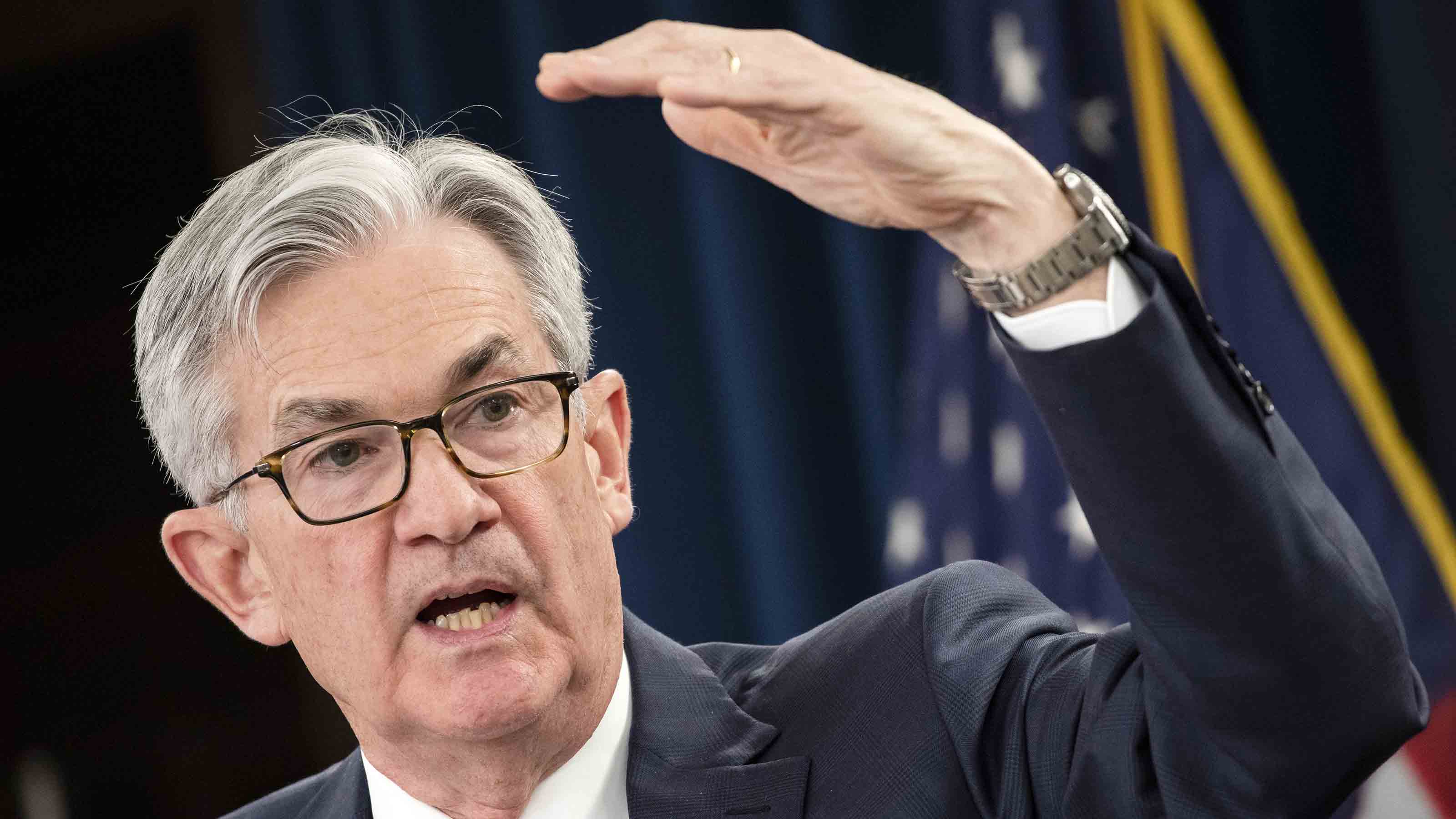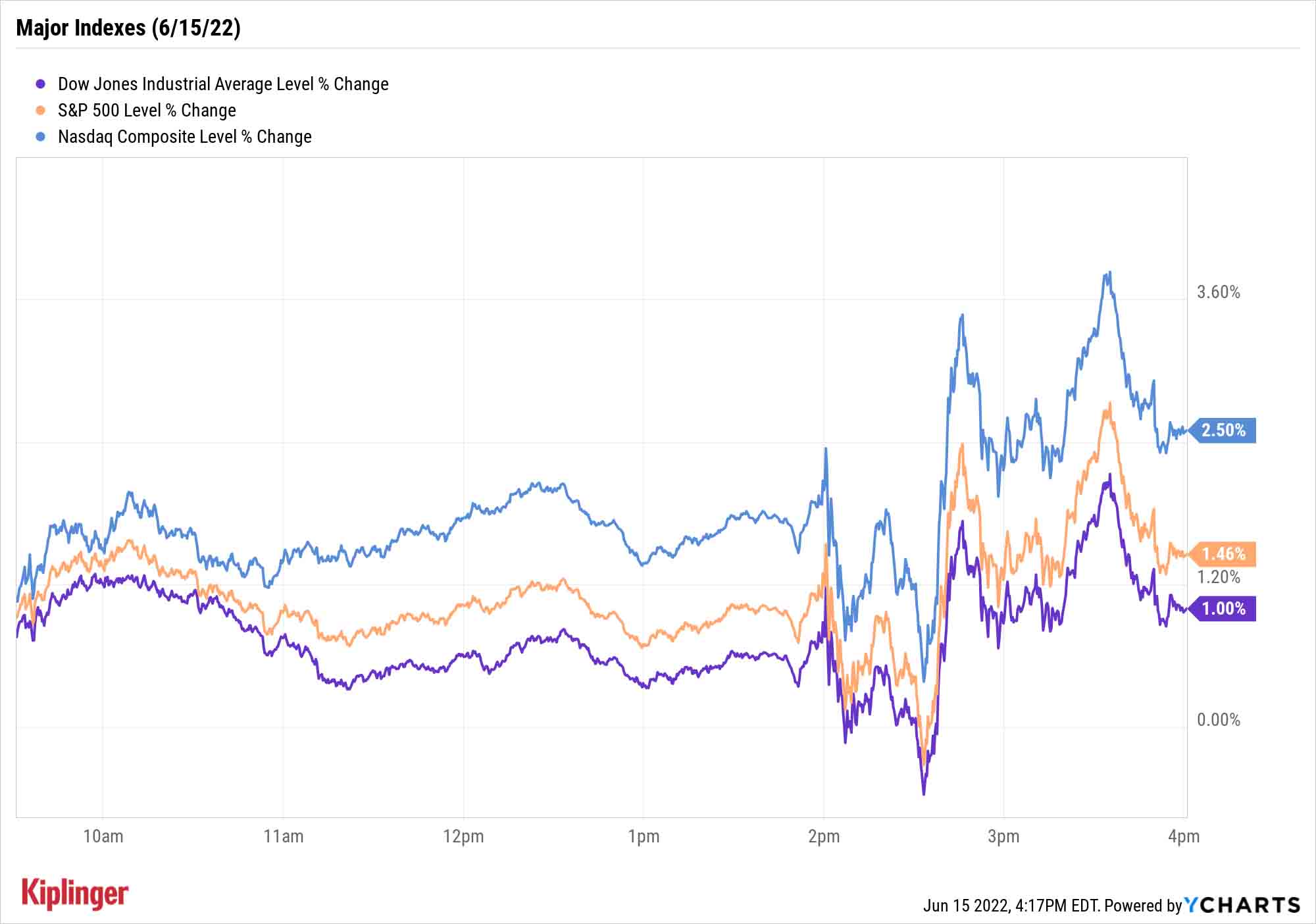Stock Market Today: Fed Goes Big, Wall Street Approves
The Fed's largest rate hike in nearly three decades, and more flexibility from Chair Powell, squeezed stocks higher Wednesday.


The Federal Reserve isn't messing around.
For months, America's central bank largely telegraphed a 50-basis-point increase to its benchmark interest rate for its June policy meeting. But on Wednesday, it instead met recently stepped-up expectations spurred by still-sizzling inflation prints, announcing a 75-basis-point hike to a range of 1.5% to 1.75% – the largest such bump since 1994. Stocks ultimately finished higher, with a little help from Fed Chair Jerome Powell.
"Even two weeks ago, we might have thought that a 0.75% increase was off the table, at least in the short term. But with inflation not letting up, it's become pretty clear that the Fed needs to take a more aggressive approach," says Mike Loewengart, managing director of investment strategy for E*Trade, who adds that retail investors should expect continued volatility as the market digests the new norm.

Sign up for Kiplinger’s Free E-Newsletters
Profit and prosper with the best of expert advice on investing, taxes, retirement, personal finance and more - straight to your e-mail.
Profit and prosper with the best of expert advice - straight to your e-mail.
The Federal Reserve's "dot plot" indicates that Federal Open Market Committee members see the benchmark rate hitting 3.4% by year's end, and 3.8% by the end of 2023 – with the possibility of rate cuts in 2024.
It's largely in the name of tamping down runaway consumer prices. The Fed, which predicted a 2.6% rate of inflation (based on the personal consumption expenditures, or PCE, index) back in December now sees a 5.2% rate by year-end 2022. And remember: The Fed's continued goal is to get that number back down to 2%.
Interestingly, another unrelated announcement Thursday – the approval of another $1 billion in military aid to Ukraine – could help that particular cause, says Sean Bonner, a 20-year-plus Wall Street veteran and the CEO of self-directed investment app Guild. Bonner says a "timely and favorable outcome" in Russia's war on Ukraine will increase global food supply, improve supply chain issues and rein in energy costs, which will benefit American consumers.
"Since it was government spending that fueled the current inflation cycle, it is paradoxical that this spending can have a direct impact on reducing inflation."
While stocks initially dipped following the Fed's post-meeting release, they perked back up after Powell continued to signal flexibility on maintaining its aggressive stance at a press conference that followed. "Clearly, today's 75-basis-point increase is an unusually large one, and I do not expect moves of this size to be common," Powell said, adding that either a 50- or 75-basis-point rate increase was on the table for the July meeting.
The Nasdaq leaped to a 2.5% gain, finishing Wednesday's trade at 11,099. The S&P 500 improved 1.5% to 3,789, while the Dow put up a 1.0% increase to 30,668.
"Today's announcement confirms the Fed's commitment to fight the inflation battle more aggressively despite the potential aftermath from raising rates at such a rapid pace," says Charlie Ripley, senior investment strategist for Allianz Investment Management. "Overall, Fed policy rates have been out of sync with the inflation story for some time, and the aggressive hikes from the Fed should appease markets for the time being."

Other news in the stock market today:
- The small-cap Russell 2000 put up a 1.4% advance to 1,731.
- U.S. crude oil futures backpedaled 3% to finish at $115.31 per barrel.
- Gold futures rose 0.3% to settle at $1,819.60 an ounce.
- Bitcoin's troubles continued, with the cryptocurrency dropping 2.1% to $21,684.50. (Bitcoin trades 24 hours a day; prices reported here are as of 4 p.m.)
- Boeing (BA) was the best Dow Jones stock today, surging 9.5%. Today's upside came on news China Southern Airlines conducted a test flight of Boeing's 737 MAX, suggesting the aircraft could return to service in the mainland after fatal crashes over the last few years have left it mostly grounded. Meanwhile, Susquehanna Financial Group analyst Charles Minervino reiterated a Positive (Buy) rating on BA stock. " Supply-chain challenges continue to be an overhang, and BA's most recent commentary has been that the goal is achieving stability before looking to increase rates," the analyst says. "While production, deliveries and orders have lagged estimates, we continue to believe strongly in BA's market position, catalyst path, and high normalized earnings power."
- Snowflake (SNOW) jumped 7.6% after Canaccord Genuity analyst David Hynes Jr. upgraded the cloud-based data platform to Buy from Hold. "From a financial standpoint, while the intermediate targets shared last quarter were reiterated, there were a bunch of incremental disclosures that give us confidence in the durable and profitable growth path that Snowflake is on," Hynes wrote in a note, saying he sees potential growth rates of 35% to 40% over the next few years. He also said he is "confident" SNOW stock – a member of the Berkshire Hathaway equity portfolio – will be higher in the years ahead. Shares closed at $122.54 today, well below the analyst's $185 price target.
The End of the Bear Market? Well ...
Alas, the bear market might not be done bottoming out – but any additional pain might be relatively short lived.
Sam Stovall, chief investment strategist for independent research firm CFRA, says that despite the possibility of a near-term relief rally sparked by the Fed's aggressive monetary policy, his firm sees the S&P 500 bear market bottoming out closer to 3,500 (-7.6% from current levels), sometime during Q3 of this year. But after that, the sun should break through the clouds:
"Encouragingly, history reminds us that new bull markets (as defined by a 20% price advance off of the bear market bottom) typically started three months after the end of the bear, which implies a year-end 2022 S&P 500 value around 4,200. What's more, based on the average 40% price jump in the 12 months after bear bottoms since WWII, look for the S&P 500 to trade around the 4,675 level by this time next year."
As we said yesterday, though, investors shouldn't be trying to hit the exact bottom. Valuations are quite depressed in a number of sectors, including real estate investment trusts (REITs) – which in turn has driven up yields significantly. Right now, the S&P 500 Real Estate sector yields 2.5% – well above the S&P 500's 1.6% – and many individual REITs yield far more than that.
Here, we look at a dozen REITs that look ripe for a rebound over the rest of 2022.
Get Kiplinger Today newsletter — free
Profit and prosper with the best of Kiplinger's advice on investing, taxes, retirement, personal finance and much more. Delivered daily. Enter your email in the box and click Sign Me Up.
Kyle Woodley is the Editor-in-Chief of WealthUp, a site dedicated to improving the personal finances and financial literacy of people of all ages. He also writes the weekly The Weekend Tea newsletter, which covers both news and analysis about spending, saving, investing, the economy and more.
Kyle was previously the Senior Investing Editor for Kiplinger.com, and the Managing Editor for InvestorPlace.com before that. His work has appeared in several outlets, including Yahoo! Finance, MSN Money, Barchart, The Globe & Mail and the Nasdaq. He also has appeared as a guest on Fox Business Network and Money Radio, among other shows and podcasts, and he has been quoted in several outlets, including MarketWatch, Vice and Univision. He is a proud graduate of The Ohio State University, where he earned a BA in journalism.
You can check out his thoughts on the markets (and more) at @KyleWoodley.
-
 12 Investments No Retiree Should Make
12 Investments No Retiree Should MakeIn retirement, when it's wise to take fewer risks with your nest egg, some investments are just nuts.
By David Rodeck
-
 What the Capital One Discover Merger Means for Your Wallet
What the Capital One Discover Merger Means for Your WalletThe Capital One Discover merger reshapes the credit card landscape and could impact your credit card rewards, interest rates and card perks.
By Paige Cerulli
-
 Stock Market Today: Trump Retreats, Markets Rejoice
Stock Market Today: Trump Retreats, Markets RejoiceStocks rally, yields soften, the dollar rises, and even beaten-down names enjoy the wages of potential trade peace.
By David Dittman
-
 Stock Market Today: Stocks Soar on China Trade Talk Hopes
Stock Market Today: Stocks Soar on China Trade Talk HopesTreasury Secretary Bessent said current U.S.-China trade relations are unsustainable and signaled hopes for negotiations.
By Karee Venema
-
 Stock Market Today: Dow Drops 971 Points as Powell Pressure Ramps Up
Stock Market Today: Dow Drops 971 Points as Powell Pressure Ramps UpPresident Trump is increasing his attacks against Jerome Powell, insisting the Fed chair cut interest rates.
By Karee Venema
-
 Stock Market Today: No 'Powell Put'? No Problem
Stock Market Today: No 'Powell Put'? No ProblemInvestors, traders and speculators look beyond both another Trump post and more signs of slowing economic activity.
By David Dittman
-
 What Is the Buffett Indicator?
What Is the Buffett Indicator?"It is better to be roughly right than precisely wrong," writes Carveth Read in "Logic: Deductive and Inductive." That's the premise of the Buffett Indicator.
By Charles Lewis Sizemore, CFA
-
 Stock Market Today: Dow Drops 699 Points After Powell Speech
Stock Market Today: Dow Drops 699 Points After Powell SpeechFed Chair Powell warned of a slowing economy and higher inflation but said the central bank isn't ready to cut rates just yet.
By Karee Venema
-
 Stock Market Today: Stocks Struggle Amid Tariff Uncertainty
Stock Market Today: Stocks Struggle Amid Tariff UncertaintyBoeing dropped after China suspended new aircraft orders, while Bank of America and Citi climbed on earnings beats.
By Karee Venema
-
 Stock Market Today: Stocks Gain on Tech, Auto Tariff Talk
Stock Market Today: Stocks Gain on Tech, Auto Tariff TalkThe Trump administration said late Friday that it will temporarily halt tariffs on some Chinese tech imports.
By Karee Venema